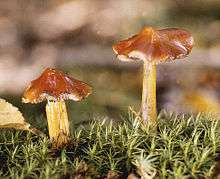Hygrocybe conica
| Hygrocybe conica | |
|---|---|
_1.jpg) | |
| Hygrocybe conica, the witch's hat - Netherlands | |
| Scientific classification | |
| Kingdom: | Fungi |
| Division: | Basidiomycota |
| Class: | Agaricomycetes |
| Order: | Agaricales |
| Family: | Hygrophoraceae |
| Genus: | Hygrocybe |
| Species: | H. conica |
| Binomial name | |
| Hygrocybe conica (Schaeff.) P.Kumm. (1871) | |
| Synonyms | |
|
List
| |
| Hygrocybe conica | |
|---|---|
|
| |
| gills on hymenium | |
| cap is conical | |
| hymenium is adnexed | |
| stipe is bare | |
| spore print is white | |
| ecology is mycorrhizal | |
| edibility: inedible | |
Hygrocybe conica, commonly known as the witch's hat, conical wax cap or conical slimy cap, is a colourful member of the genus Hygrocybe (the waxcaps), found across northern Europe and North America. Originally described as Hygrophorus conicus, it may actually be a complex of closely related and similar species.
Taxonomy
The species was first described scientifically in 1774 by German polymath Jacob Christian Schäffer, who named it Agaricus conicus.[1] Paul Kummer transferred it to the genus Hygrocybe in 1871.[2]
Description

The witch's hat is a small mushroom, with a convex to conical yellow-orange to red cap 2 to 5 cm (¾-2 inches) in diameter, though very occasionally larger specimens up to 8 or 9 cm (3½ in) diameter are found. It turns black when cut or bruised.
Distribution and habitat
The witch's hat is widely distributed in grasslands and conifer woodlands across North America, Europe and Asia, as well as Australia and New Zealand, being found in summer and autumn. It is likely that what is currently termed Hygrocybe conica is actually a complex of closely related species, some of which are suspected of being poisonous.[3] Though Hygrocybe conica does occur in Australia, principally near urban areas, many collections originally assigned to this species are actually the similar Hygrocybe astatogala.[4]
Edibility
The edibility or otherwise of Hygrocybe conica is unclear. Its small size and being coated in a sticky substance render it of limited palatability anyway, however there is a report of poisoning from China in the early part of the 20th century which was allegedly from this species.[5]
See also
References
- ↑ Schaeffer, Julius C. (1774). Fungorum qui in Bavaria et Palatinatu circa Ratisbonam nascuntur Icones (in Latin). 4. Regensburg. p. 2.
- ↑ Kummer P. (1871). Der Führer in die Pilzkunde (in German). Zerbst: C. Luppe. p. 111.
- ↑ Nilsson S, Persson O (1977). Fungi of Northern Europe 2: Gill-Fungi. New York, New York: Penguin. ISBN 0-14-063006-6.
- ↑ Young AM (2005). Fungi of Australia: Hygrophoraceae. Canberra, ACT: (Australian Biological Resources Study) CSIRO. ISBN 0-643-09195-5.
- ↑ Kuo M. "Hygrocybe conica". Mushroomexpert. Retrieved 21 October 2015.
- Phillips, Roger (1991). Mushrooms of North America. Little, Brown & Co., New York. ISBN 0-316-70612-4.
- Führer, Bruce Alexander (2005) A Field Guide to Australian Fungi Bloomings Books, Melbourne, Australia, ISBN 1-876473-51-7
External links
- Hygrocybe conica in Index Fungorum
- "Fungus of the Month for October 2001: Hygrocybe conica, the witch's hat mushroom" by Tom Volk, TomVolkFungi.net.
| Wikimedia Commons has media related to Hygrocybe conica. |